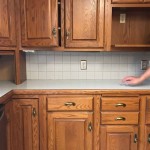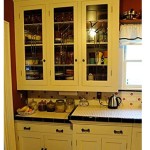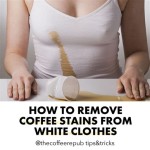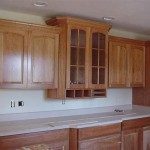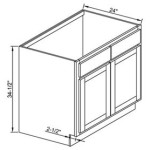How To Clean Oak Kitchen Cupboards
Oak kitchen cupboards, prized for their durability and natural beauty, require regular cleaning and maintenance to keep them looking their best. The porous nature of oak wood means that it can easily absorb grease, dirt, and spills, leading to a build-up that diminishes its aesthetic appeal. Consistent cleaning, using appropriate techniques and products, is essential to prevent permanent damage and preserve the integrity of the wood.
The frequency of cleaning depends on the level of use and exposure to cooking residues. Cupboards located near the stove often require more frequent cleaning than those positioned further away. Generally, a light cleaning should be performed weekly, while a more thorough cleaning is recommended monthly. Addressing spills and splatters immediately prevents them from setting and becoming more difficult to remove.
Before beginning any cleaning process, it is crucial to identify the type of finish applied to the oak cupboards. Different finishes require different cleaning approaches. Some common finishes include polyurethane, varnish, lacquer, and oil-based finishes. Determining the finish type ensures that the chosen cleaning method will not damage or discolor the wood.
This article provides a comprehensive guide on how to effectively clean oak kitchen cupboards, covering essential steps from preparation to maintenance. These steps assist in achieving a clean, well-maintained kitchen environment while preserving the natural beauty and longevity of the oak cupboards.
Preparing to Clean Oak Kitchen Cupboards
The preparation stage is critical for a successful cleaning process. It involves gathering the necessary cleaning supplies and taking steps to protect the surrounding surfaces. Adequate preparation not only streamlines the cleaning process but also minimizes the risk of damage to the cupboards and the kitchen environment.
First, gather the following essential cleaning supplies: * A soft, clean microfiber cloth: Microfiber cloths are ideal for cleaning wood surfaces as they are gentle, non-abrasive, and effectively lift dirt and grime without scratching the finish. * Warm water: Warm water helps to loosen dirt and grease, making it easier to remove. * Mild dish soap: A mild dish soap, free of harsh chemicals or abrasives, is effective for cutting through grease and grime without damaging the wood finish. * White vinegar (optional): White vinegar can be used as a natural cleaning agent for more stubborn stains and grease. However, it should be diluted with water to prevent damage to the finish. * Baking soda (optional): Baking soda is a mild abrasive that can be used to remove stubborn stains. It should be used with caution and tested in an inconspicuous area first. * A spray bottle: A spray bottle is useful for applying cleaning solutions evenly to the cupboard surfaces. * A soft-bristled brush (optional): A soft-bristled brush can be used to clean hard-to-reach areas and crevices. * Cleaning gloves: Cleaning gloves protect hands from harsh cleaning agents and prevent the transfer of oils and dirt from hands to the cupboard surfaces. * Protective sheeting or drop cloths: These are used to protect countertops and flooring from drips and spills during the cleaning process.
Next, prepare the cleaning area. Remove all items from the countertops below the cupboards to prevent them from getting wet or damaged. Place protective sheeting or drop cloths over the countertops and flooring to catch any drips or spills. This step is particularly important when using spray bottles or cleaning solutions that may run.
Finally, before applying any cleaning solution to the entire surface, test it on an inconspicuous area of the cupboard, such as the inside of a door or the back of a drawer. This test helps determine if the cleaning solution will damage or discolor the finish. Apply a small amount of the cleaning solution to the test area, let it sit for a few minutes, and then wipe it off with a clean cloth. Observe the area for any signs of damage, discoloration, or dulling of the finish. If there are no adverse effects, proceed with cleaning the rest of the cupboards.
Cleaning Techniques for Oak Kitchen Cupboards
Once the preparation is complete, it is time to clean the oak kitchen cupboards. The cleaning technique depends on the type of finish and the level of dirt and grime. Gentle cleaning methods should always be employed initially, progressing to more intensive methods only if necessary.
For general cleaning, start with a mixture of warm water and mild dish soap. In a bucket or spray bottle, combine a few drops of mild dish soap with warm water. The solution should be lightly sudsy. Dip a clean microfiber cloth into the solution, wring it out thoroughly to prevent excessive moisture, and then wipe down the cupboard surfaces. Work in small sections, rinsing the cloth frequently to remove dirt and grime. After wiping each section, use a clean, dry microfiber cloth to remove any excess moisture. This prevents water spots and helps to maintain the finish of the cupboards.
For stubborn stains and grease, a slightly stronger cleaning solution may be necessary. One option is to use a mixture of white vinegar and water. Combine equal parts white vinegar and water in a spray bottle. Spray the solution onto the stained or greasy areas, let it sit for a few minutes to loosen the grime, and then wipe it off with a clean microfiber cloth. As with the soap and water solution, it is important to dry the surface thoroughly after cleaning. Another option for tackling stubborn stains is to use a paste of baking soda and water. Mix a small amount of baking soda with water to form a thick paste. Apply the paste to the stained area, gently rub it in a circular motion with a soft cloth, and then wipe it off with a clean, damp cloth. Ensure that all traces of baking soda are removed to prevent a chalky residue.
When cleaning oak cupboards with intricate carvings or detailing, a soft-bristled brush can be invaluable. Dip the brush into the cleaning solution and gently scrub the crevices and hard-to-reach areas. Be careful not to apply too much pressure, as this can damage the finish. After scrubbing, wipe the area with a clean, damp cloth to remove any remaining dirt and cleaning solution. Use a dry cloth to thoroughly dry the area.
Avoid using abrasive cleaners, scouring pads, or steel wool on oak kitchen cupboards. These materials can scratch and damage the finish, leaving the wood vulnerable to moisture and dirt. Harsh chemicals, such as bleach or ammonia, should also be avoided, as they can discolor or strip the finish. Always test any cleaning solution in an inconspicuous area before applying it to the entire surface.
Maintaining Oak Kitchen Cupboards
Regular maintenance is key to preserving the beauty and longevity of oak kitchen cupboards. Simple preventative measures and consistent care can significantly reduce the need for intensive cleaning and prevent long-term damage.
First, wipe up spills immediately. Liquids, especially acidic substances like juice or vinegar, can stain or damage the finish if left to sit. Use a clean, dry cloth to blot the spill and prevent it from spreading. Avoid rubbing the spill, as this can push it deeper into the wood pores. For sticky spills, use a slightly damp cloth to loosen the residue before wiping it clean.
Second, use range hood while cooking. The range hood helps to vent cooking fumes and grease, preventing them from accumulating on the cupboard surfaces. Ensure that the range hood is clean and functioning properly to maximize its effectiveness. Clean the range hood filters regularly to remove accumulated grease and prevent it from dripping onto the cupboards below.
Third, apply furniture polish or wood conditioner periodically. Furniture polish or wood conditioner can help to protect the finish and keep the wood moisturized. Follow the manufacturer's instructions for application. Typically, the polish or conditioner is applied with a clean cloth and then buffed to a shine. Choose a product that is specifically designed for use on oak wood and is compatible with the type of finish on the cupboards.
Fourth, control humidity levels in the kitchen. Excessive humidity can cause wood to warp or crack. Use a dehumidifier or air conditioner to maintain a consistent humidity level in the kitchen. Avoid placing oak cupboards near sources of heat or moisture, such as the dishwasher or oven, as this can exacerbate the effects of humidity.
Fifth, avoid using harsh chemicals or abrasive cleaners. As previously mentioned, these materials can damage the finish and leave the wood vulnerable to moisture and dirt. Stick to mild cleaning solutions and gentle cleaning methods to protect the cupboards. When in doubt, consult a professional wood refinisher for guidance on the best cleaning and maintenance practices for specific type of oak finish.
By following these cleaning techniques and maintenance tips, one can ensure that their oak kitchen cupboards remain clean, beautiful, and functional for years to come. Consistent care and attention to detail are essential for preserving the natural beauty and integrity of the wood.

5 Expert Ways To Clean Wooden Kitchen Cabinets Everyday Old House

How To Clean Oak Cabinets With Pictures Wikihow

How To Clean Prep Wood Kitchen Cabinets Before Painting Do Dodson Designs
How To Clean Sticky Wood Kitchen Cabinets Quora

How To Clean Kitchen Cabinets Everyday Skate

4 Proven Ways To Clean Sticky Wood Kitchen Cabinets Lovetoknow

How To Clean Solid Oak Kitchen Cabinets Wood Information Guides

How To Clean Prep Wood Kitchen Cabinets Before Painting Do Dodson Designs

3 Ways To Clean Wood Kitchen Cabinets Wikihow Life

How To Clean World Class Oak Kitchen Cabinets
Related Posts

